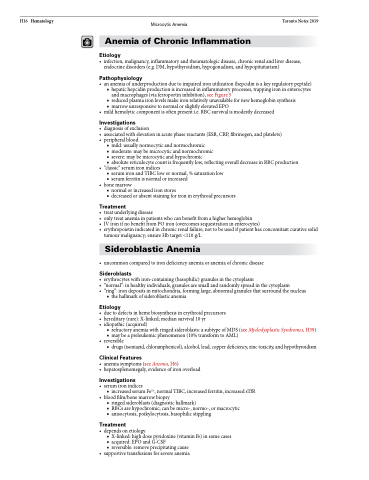Page 556 - TNFlipTest
P. 556
H16 Hematology
Microcytic Anemia Toronto Notes 2019 Anemia of Chronic Inflammation
Etiology
• infection,malignancy,inflammatoryandrheumatologicdisease,chronicrenalandliverdisease, endocrine disorders (e.g. DM, hypothyroidism, hypogonadism, and hypopituitarism)
Pathophysiology
• ananemiaofunderproductionduetoimpairedironutilization(hepcidinisakeyregulatorypeptide) ■ hepatic hepcidin production is increased in inflammatory processes, trapping iron in enterocytes
and macrophages (via ferroportin inhibition), see Figure 5
■ reduced plasma iron levels make iron relatively unavailable for new hemoglobin synthesis ■ marrow unresponsive to normal or slightly elevated EPO
• mildhemolyticcomponentisoftenpresenti.e.RBCsurvivalismodestlydecreased
Investigations
• diagnosisofexclusion
• associatedwithelevationinacutephasereactants(ESR,CRP,fibrinogen,andplatelets) • peripheralblood
■ mild: usually normocytic and normochromic
■ moderate: may be microcytic and normochromic
■ severe: may be microcytic and hypochromic
■ absolute reticulocyte count is frequently low, reflecting overall decrease in RBC production
• “classic”serumironindices
■ serumironandTIBClowornormal,%saturationlow ■ serum ferritin is normal or increased
• bonemarrow
■ normal or increased iron stores
■ decreased or absent staining for iron in erythroid precursors
Treatment
• treatunderlyingdisease
• onlytreatanemiainpatientswhocanbenefitfromahigherhemoglobin
• IVironifnobenefitfromPOiron(overcomessequestrationinenterocytes)
• erythropoietinindicatedinchronicrenalfailure;nottobeusedifpatienthasconcomitantcurativesolid
tumour malignancy; ensure Hb target <110 g/L
Sideroblastic Anemia
• uncommoncomparedtoirondeficiencyanemiaoranemiaofchronicdisease
Sideroblasts
• erythrocyteswithiron-containing(basophilic)granulesinthecytoplasm
• “normal”:inhealthyindividuals,granulesaresmallandrandomlyspreadinthecytoplasm
• “ring”:irondepositsinmitochondria,forminglarge,abnormalgranulesthatsurroundthenucleus
■ the hallmark of sideroblastic anemia
Etiology
• duetodefectsinhemebiosynthesisinerythroidprecursors • hereditary(rare):X-linked;mediansurvival10yr
• idiopathic(acquired)
■ refractory anemia with ringed sideroblasts: a subtype of MDS (see Myelodysplastic Syndromes, H39)
■ maybeapreleukemicphenomenon(10%transformtoAML) • reversible
■ drugs(isoniazid,chloramphenicol),alcohol,lead,copperdeficiency,zinctoxicity,andhypothyroidism
Clinical Features
• anemiasymptoms(seeAnemia,H6)
• hepatosplenomegaly,evidenceofironoverload
Investigations
• serumironindices
■ increased serum Fe2+, normal TIBC, increased ferritin, increased sTfR
• bloodfilm/bonemarrowbiopsy
■ ringed sideroblasts (diagnostic hallmark)
■ RBCs are hypochromic; can be micro-, normo-, or macrocytic ■ anisocytosis, poikylocytosis, basophilic stippling
Treatment
• dependsonetiology
■ X-linked: high dose pyridoxine (vitamin B6) in some cases ■ acquired: EPO and G-CSF
■ reversible: remove precipitating cause
• supportivetransfusionsforsevereanemia


